
Thomas Patrick John Anson, 5th Earl of Lichfield, was an English photographer from the Anson family. He inherited the Earldom of Lichfield in 1960 from his paternal grandfather. In his professional practice he was known as Patrick Lichfield.

Ice Cold in Alex is a 1958 British war film set during the Western Desert campaign of World War II based on the novel of the same name by Christopher Landon. Directed by J. Lee Thompson and starring John Mills, the film was a prizewinner at the 8th Berlin International Film Festival. Under the title Desert Attack, a shortened, 79-minute version of the film was released in the United States in 1961. Film critic Craig Butler later referred to the shortened versions as nonsensical.
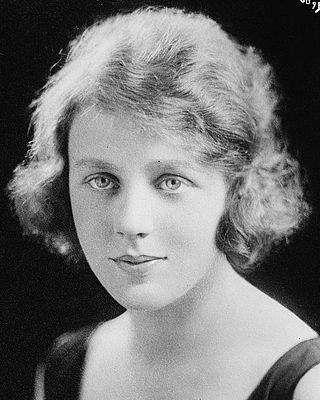
Edna Clara Best was a British actress.

Robert Edward Stevenson was a British-American screenwriter and film director.

The Royal Family is a play written by George S. Kaufman and Edna Ferber. Its premiere on Broadway was at the Selwyn Theatre on 28 December 1927, where it ran for 345 performances to close in October 1928. It was included in Burns Mantle's The Best Plays of 1927–1928.

Herbert Brough Falcon Marshall was an English stage, screen, and radio actor who starred in many popular and well-regarded Hollywood films in the 1930s and 1940s. After a successful theatrical career in the United Kingdom and North America, he became an in-demand Hollywood leading man, frequently appearing in romantic melodramas and occasional comedies. In his later years, he turned to character acting.
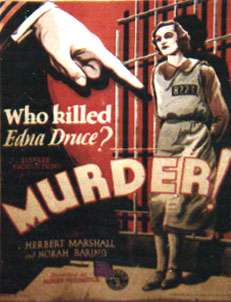
Murder! is a 1930 British thriller film co-written and directed by Alfred Hitchcock and starring Herbert Marshall, Norah Baring and Edward Chapman. Written by Hitchcock, his wife Alma Reville and Walter C. Mycroft, it is based on the 1928 novel Enter Sir John by Clemence Dane and Helen Simpson. It was Hitchcock's third all-talkie film, after Blackmail (1929) and Juno and the Paycock (1930).
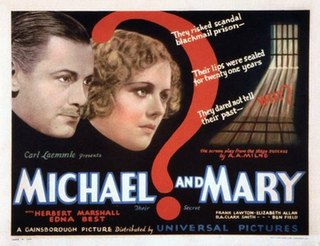
Michael and Mary is a 1931 British drama film directed by Victor Saville and starring Elizabeth Allan, Edna Best, Frank Lawton, and Herbert Marshall. This was the first of the Edna Best and Herbert Marshall co-starring talkies. It was based on a play of the same name by A.A. Milne. Milne's story was adapted by Lajos Bíró,Robert Stevenson and Angus MacPhail. Produced by Gainsborough Pictures, it was shot at the company's Islington Studios in London. The film's sets were designed by the art director Alex Vetchinsky.
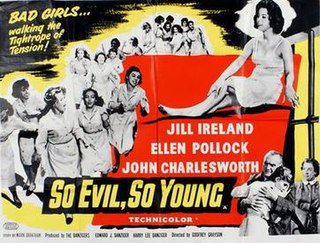
So Evil, So Young is a 1961 British Technicolor reform school prison film produced by the Danzigers, directed by Godfrey Grayson, and starring Jill Ireland and Ellen Pollock.

The House of Trent is a 1933 British drama film directed by Norman Walker and starring Anne Grey, Wendy Barrie, Moore Marriott and Peter Gawthorne. It follows a doctor who faces both a scandal and a moral dilemma when a patient of his dies while he is making love to a press magnate's daughter. It was also released as Trent's Folly. The film was made at Ealing Studios in London.

The Calendar is a black and white 1948 British drama film directed by Arthur Crabtree and starring Greta Gynt, John McCallum, Raymond Lovell and Leslie Dwyer. It is based on the 1929 play The Calendar and subsequent novel by Edgar Wallace. A previous version had been released in 1931.
Leap Year is a 1932 British comedy film directed by Tom Walls, who co-stars with Anne Grey, Edmund Breon and Ellis Jeffreys. Made at British and Dominion's Elstree Studios, it was written by A. R. Rawlinson, and produced by Herbert Wilcox. The film was re-released in 1937.
City of Beautiful Nonsense is a 1919 British silent film drama directed by Henry Edwards, who also starred in the film with Chrissie White. The film is based on the best-selling 1909 novel of the same name by E. Temple Thurston, and is a tale of a woman intending to marry for financial gain and security, who realises at the last minute that to be true to herself and to have the prospect of a happy future she must instead marry for love. A sound version of the same story was made in 1935 by Adrian Brunel.

The Faithful Heart is a 1932 British drama film directed by Victor Saville and starring Herbert Marshall, Edna Best and Anne Grey. It is based on the 1921 play The Faithful Heart by Monckton Hoffe. It was made at Islington Studios of Gainsborough Pictures in London. The film's sets were designed by Alex Vetchinsky.
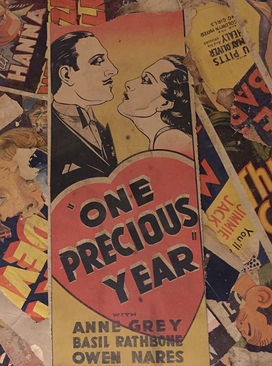
One Precious Year is a 1933 British drama film directed by Henry Edwards and starring Anne Grey, Basil Rathbone and Owen Nares. It was made at British and Dominion Elstree Studios by the British producer Herbert Wilcox for release by the British subsidiary of Paramount Pictures. The film's sets were designed by the art director C. Wilfred Arnold.
The Calendar is a 1929 play by the British writer Edgar Wallace. It is a crime thriller set in the world of horse racing world, the sport being among Wallace's interests. The protagonist is a financially struggling racehorse owner with a shady reputation. It premiered at the Palace Theatre in Manchester before transferring to Wyndham's Theatre in the West End.
Mumsie or Mumsée is a 1920 play by the Anglo-American writer Edward Knoblock.

There's Always Juliet is a 1931 comedy play by the British writer John Van Druten about an American architect who falls in love with an Englishwoman.
Sleeping Partners is a 1930 British comedy film directed by Seymour Hicks and starring Hicks, Edna Best and Lyn Harding. It is based on the 1916 play Let's Make a Dream by Sacha Guitry. It was shot at Islington Studios.

Michael and Mary is a play by the British author A.A. Milne. It was staged at the Charles Hopkins Theatre in New York City, running for 246 performances between December 1929 and July 1930. It had by then transferred to the St James's Theatre in London's West End where it ran for 159 performances between 1 February and 21 June 1930. The original West End cast included Herbert Marshall, Edna Best, Elizabeth Allan, Frank Lawton, D.A. Clarke-Smith, Reginald Bach, Oliver Wakefield, J. Fisher White, Torin Thatcher, Olwen Brookes and Margaret Scudamore.















